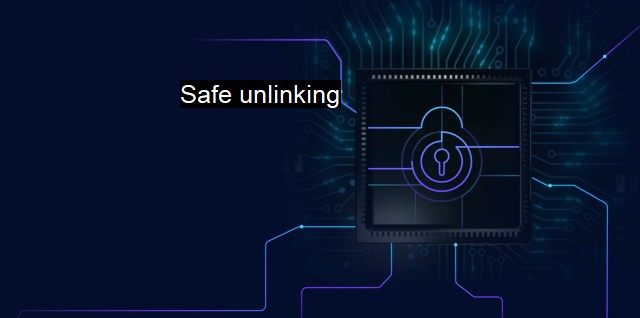What is Safe unlinking?
Safe Unlinking in Cybersecurity: Protecting Sensitive Data from Malicious Actors
"Safe unlinking" is a crucial cybersecurity concept that's associated with dynamic memory management in programming, primarily used to prevent specific exploitation types named doubly linked list pointer corruption. It involves unlinking or separating one node or object from others in a doubly linked list, which, if not done correctly, can make your system vulnerable to malicious attacks. Understanding this particular concept is crucial for anyone involved including programmers and antivirus software developers as it aids in creating sophisticated software that can guard against potential threats.A doubly linked list is a fundamental data structure in computer science, which has two pointers or links. Each link points to the next and the previous node in the sequence. These lists provide various operations like insertions and deletions, but a significant issue arises during the unlink operation.
Traditionally while removing a node in a doubly linked list, prior and next pointers play crucial roles. The prior pointer of the next object and the next pointer of the prior object are adjusted to point towards each other, thereby removing all links to the node being unhooked. If not handled securely, this action may manipulate arbitrary memory write, providing an attacker with the ability to override the pointer and change its values. Consequently, it opens up the system to severe security risks like arbitrary memory write vulnerabilities.
"Safe unlinking" aims to counteract this risk. It is a protocol employed when unhooking any doubly linked list node. Implemented in several different ways depending on the context, its principle remains relatively consistent. Before unlinking a node, it cross-verifies the 'prior' and 'next' pointers of the node with the respective elements in adjacent nodes ensuring they correctly reference each other. If discrepancies exist, it indicates a potential corruption, and the unlink operation is abruptly stopped, preventing an arbitrary memory override. Therefore, safe unlinking primarily functions as a protection measure against explicit pointer corruption.
The developer must be vigilant about proper implementation for the safe unlinking technique to be highly effective. Sloppy implementation may result in performance penalties, increase in complexity and difficulty in maintenance. the additional layer of verification to secure the integrity of the doubly linked list is generally worth the tradeoff given the significant protection it offers.
Safe unlinking is a cornerstone concept within antivirus software design. This defense mechanism prevents attackers from exploiting the system via corrupted pointers, subsequently creating a secure software environment. Antivirus software providers that work with systems like Kernel Patch Protection to protect crucial kernel structures on Windows use safe unlinking methods.
Safe unlinking is a critical cybersecurity mechanism used to deal with the challenges associated with doubly linked list pointer corruption. It's a defensive procedure that helps ensure safe operations within software systems, safeguarding against unauthorized access and vulnerabilities. Developers in the field of antivirus software design and those managing systems dealing with sensitive data must cautiously apply this technique to maintain system integrity and blank out potential security threats.
While unlinking operations on a doubly linked list offer potential opportunities for executing arbitrary code when maliciously exploited, safe unlinking provides a key guard against such forms of cyber-attack. By integrating careful and properly implemented safe unlinking procedures in their code, software developers can protect systems against dangerous breaches and enhance the overall security for their users.

Safe unlinking FAQs
What is safe unlinking in cybersecurity?
Safe unlinking in cybersecurity refers to the process of safely removing a file or program from a computer system without causing any harm to other files or programs. It is an important security measure that helps to prevent malware infections, data breaches, and other cyber threats.Why is safe unlinking important in antivirus software?
Safe unlinking is an essential feature in antivirus software because it helps to prevent malware from spreading and causing damage to other files on a computer. When an infected file is detected, the antivirus software will use safe unlinking to remove it from the system without inadvertently spreading the malware to other files.What are some common techniques used in safe unlinking?
There are several common techniques used in safe unlinking, including quarantine, isolation, and sandboxing. Quarantine involves moving a potentially infected file to a secure location where it can be analyzed and isolated from other files. Isolation involves placing the infected file in a virtual environment where it can be safely examined without affecting other files on the system. Sandboxing involves running the file in a secure and controlled environment to determine if it is safe to use.Can safe unlinking guarantee 100% security against cyber threats?
While safe unlinking is an important security measure, it cannot guarantee 100% protection against all cyber threats. It is still possible for malware and other cyber threats to bypass antivirus software and infect a system. However, using safe unlinking in combination with other security measures such as firewalls, strong passwords, and software updates can greatly reduce the risk of cyber attacks.| | A | | | B | | | C | | | D | | | E | | | F | | | G | | | H | | | I | | | J | | | K | | | L | | | M | |
| | N | | | O | | | P | | | Q | | | R | | | S | | | T | | | U | | | V | | | W | | | X | | | Y | | | Z | |
| | 1 | | | 2 | | | 3 | | | 4 | | | 7 | | | 8 | | |||||||